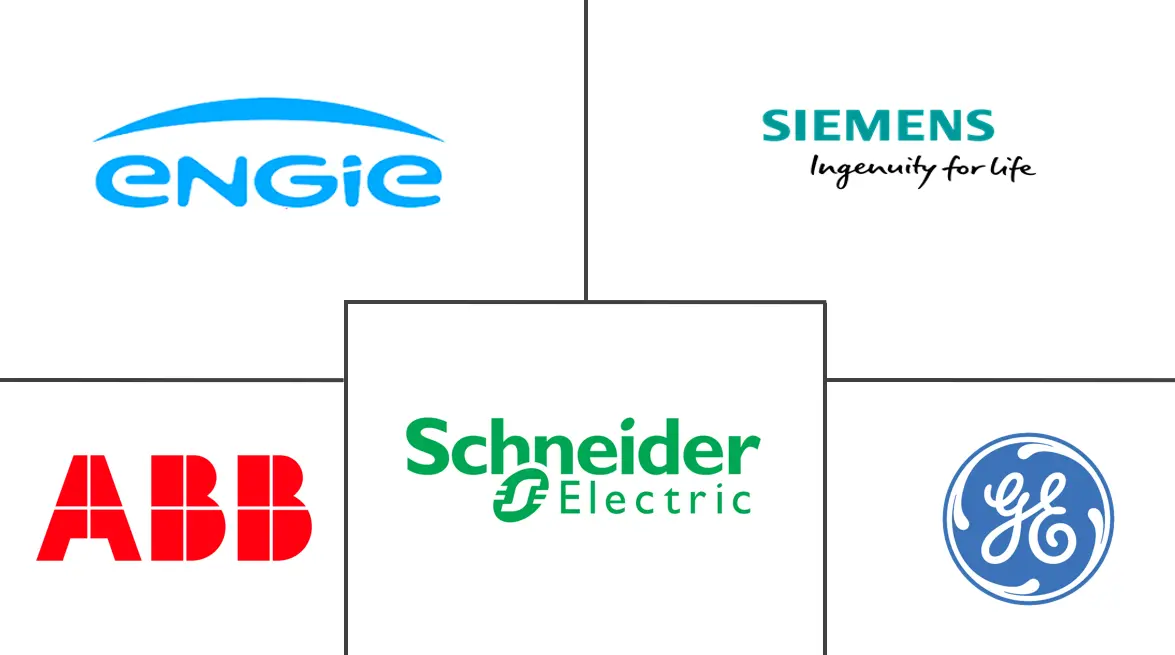Distributed Energy Resource Management System Market Size and Share
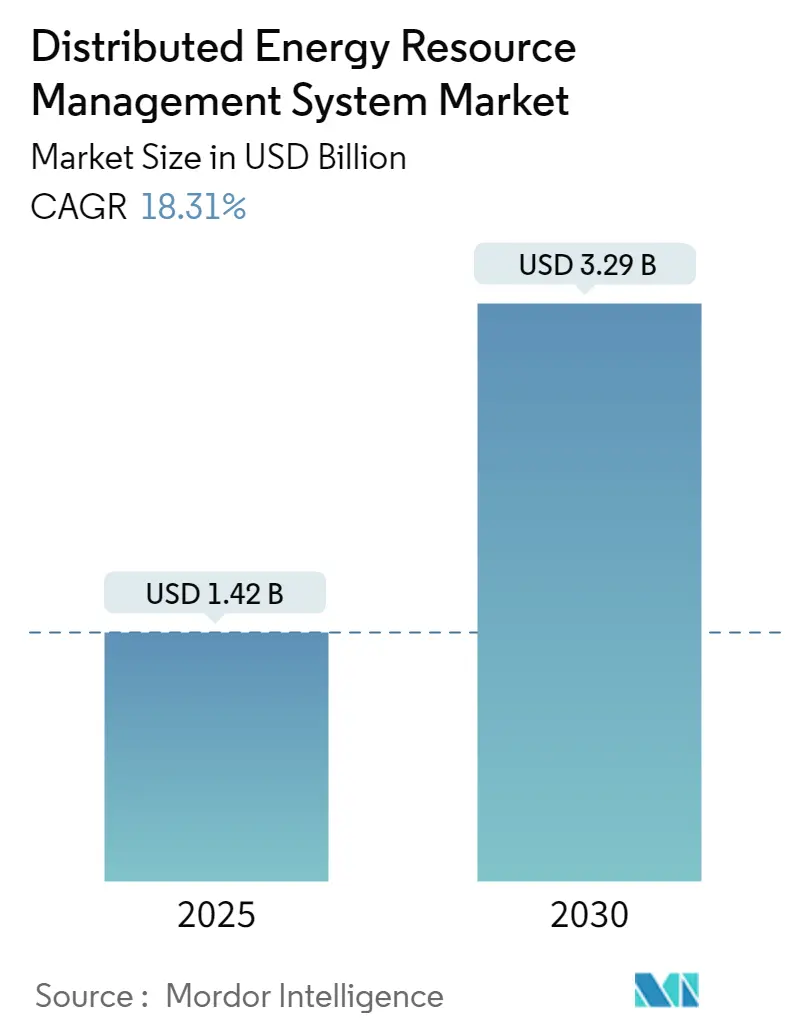
Distributed Energy Resource Management System Market Analysis by Mordor Intelligence
The Distributed Energy Resource Management System Market size is estimated at USD 1.42 billion in 2025, and is expected to reach USD 3.29 billion by 2030, at a CAGR of 18.31% during the forecast period (2025-2030).
The Distributed Energy Resource Management System landscape is experiencing rapid technological transformation, driven by the integration of artificial intelligence and advanced analytics. According to the N.C. Clean Energy Technology Center, a total of 774 grid modernization actions were taken across more than fifty states during 2023, highlighting the industry's commitment to infrastructure advancement. These actions encompassed various initiatives, including growing interest in virtual power plants, examining wholesale market participation impacts, studying long-duration energy storage, and implementing new performance incentive mechanisms. The integration of AI-driven solutions has enabled more sophisticated forecasting capabilities, predictive maintenance, and real-time optimization of distributed energy resources.
The industry is witnessing a significant shift toward enhanced grid resilience and cybersecurity measures. In March 2024, the U.S. Department of Security announced plans for a microgrid project in rural Iowa, representing a federal investment of USD 9.5 million with an additional USD 2.4 million from Iowa State University. This trend is further exemplified by the deployment of advanced monitoring technologies, including Internet of Things (IoT) sensors and smart meters, which facilitate real-time data collection and analysis for improved grid stability and security. The integration of blockchain technology is emerging as a crucial development, enabling secure and efficient connectivity among smart grids, smart meters, and utilities while enhancing communication between operators and consumers.
The market is experiencing a notable transformation in electric vehicle (EV) charging infrastructure integration. In Canada alone, as of March 2023, there were 20,478 charging connectors distributed across 8,732 charging station sites nationwide, representing a substantial 30% growth since early 2022. This rapid expansion of EV charging infrastructure has necessitated more sophisticated DERMS solutions capable of managing the increasing grid demands and optimizing charging patterns to prevent system overload. The industry is responding with innovative solutions that incorporate vehicle-to-grid (V2G) capabilities and smart charging algorithms.
Australia's remarkable progress in distributed energy adoption showcases the market's evolution, with the country achieving the world's highest share of rooftop solar per capita. By the end of 2022, total rooftop capacity reached 19 GW, with installations present in more than 30% of the country's households. This widespread adoption has catalyzed innovations in energy storage integration and virtual power plant development. The industry is witnessing increased focus on grid-interactive capabilities, with utilities and technology providers developing more sophisticated platforms for managing bidirectional power flows and aggregating distributed energy resources for grid services.
Global Distributed Energy Resource Management System Market Trends and Insights
Increasing Shift Toward Renewables-based Distributed Power Generation
The exponential increase in renewable energy adoption, particularly distributed energy resources, has emerged as a primary driver for the distributed energy resource management system market. According to the International Renewable Energy Agency, global solar PV installed capacity reached 1,046.61 GW in 2022, demonstrating a substantial annual growth rate of 22.4% compared to the previous year. This remarkable growth is further evidenced by the International Energy Agency's report showing that solar PV generation increased by 26% in 2022, reaching 1300 TWh, representing the largest absolute generation growth among all renewable technologies. The surge in distributed generation has been particularly notable in the residential and commercial sectors, where rooftop solar installations have become increasingly prevalent, allowing end users to generate their own power and even sell excess energy back to power companies.
The shift toward renewables-based distributed power generation is being accelerated by supportive government policies and declining technology costs. Governments worldwide are implementing various initiatives to promote distributed energy resources, as exemplified by India's Grid-connected Rooftop Solar Scheme extension to March 2026, targeting 40 GW of rooftop solar capacity. The economic viability of distributed generation has significantly improved, requiring substantially less capital than equivalent traditional facilities. This is primarily due to the dramatic reduction in solar photovoltaic costs over the past six years, driven by increased equipment availability and manufacturing efficiencies. The integration of electric vehicle charging infrastructure has further amplified this trend, as demonstrated by Canada's rapid expansion of charging networks, which grew by 30% in 2022 to reach 20,478 charging connectors across 8,732 stations. These developments collectively underscore the growing importance of distributed energy resource management systems in efficiently managing and optimizing these diverse energy resources.
Moreover, the role of smart energy management systems in enhancing the efficiency of distributed energy resources cannot be overstated. By leveraging advanced technologies, these systems facilitate the seamless integration of renewable energy sources into the grid, thereby optimizing the overall energy management system. The concept of a virtual power plant is also gaining traction, allowing for the aggregation of multiple distributed energy resources to function as a unified entity within the power distribution management framework. This innovative approach not only enhances grid stability but also maximizes the utilization of available energy resources, further driving the growth of the distributed energy resource management system market.
Segment Analysis: Technology
Solar Photovoltaic Segment in Distributed Energy Resource Management System Market
The Solar Photovoltaic segment dominates the global Distributed Energy Resource Management System market, commanding approximately 51% of the market share in 2024. This significant market position is driven by the increasing adoption of solar PV systems across residential, commercial, and industrial sectors worldwide. The segment's growth is particularly notable in regions like Asia-Pacific and North America, where government initiatives and declining solar panel costs have accelerated deployment. For instance, in February 2024, the Australian government announced significant investments in rooftop solar initiatives, while the United States continues to expand its solar infrastructure through various federal and state-level programs. The integration of solar PV with energy storage management systems and smart grid technologies has further enhanced the demand for DERMS in this segment, as utilities and energy providers seek to optimize the generation, storage, and distribution of solar power.
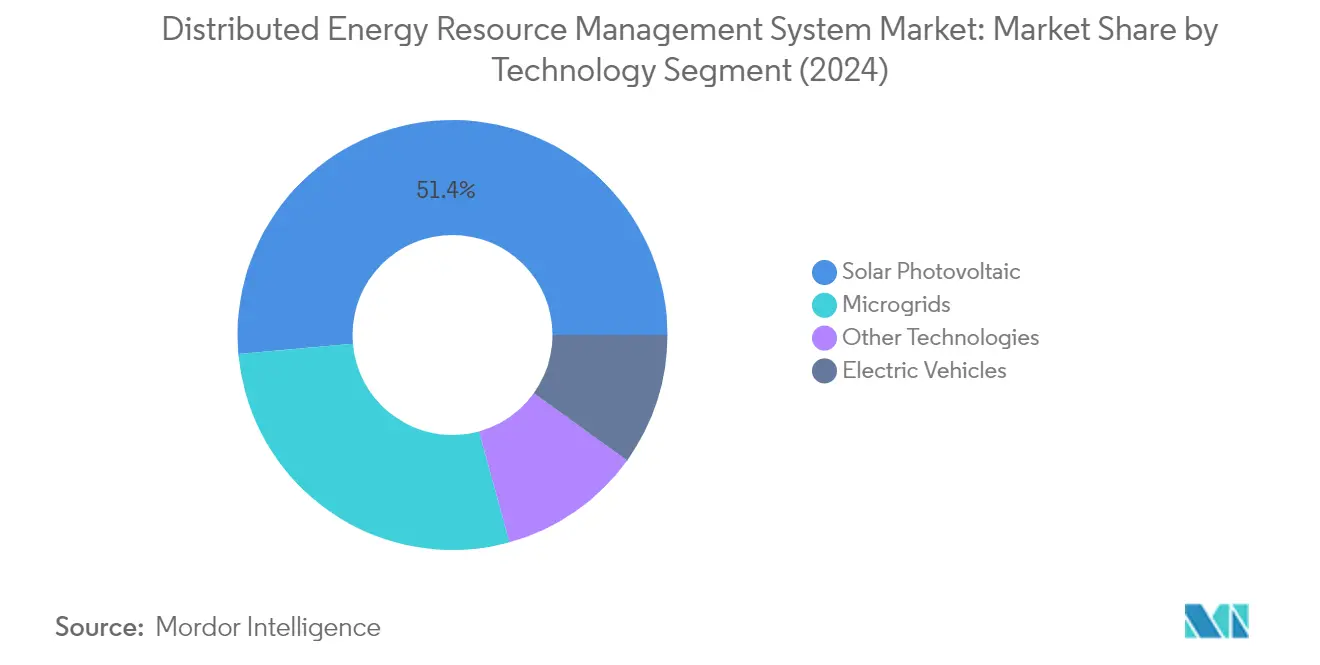
Electric Vehicles Segment in Distributed Energy Resource Management System Market
The Electric Vehicles segment is emerging as the fastest-growing segment in the DERMS market, projected to grow at approximately 23% during 2024-2029. This remarkable growth is driven by the rapid expansion of electric vehicle charging infrastructure and the increasing need to manage grid impacts from EV charging loads. The segment's growth is supported by major automotive manufacturers' commitments to electrification and government initiatives promoting EV adoption. For example, in March 2024, several European countries announced new investments in smart charging infrastructure, while China continues to lead global EV adoption with extensive charging network deployments. The integration of vehicle-to-grid (V2G) technology and smart charging solutions has created additional opportunities for DERMS providers, as utilities seek to leverage EVs as flexible grid assets for demand response and grid stability applications. The role of virtual power plant technology in this segment is also becoming increasingly important.
Remaining Segments in Technology
The Microgrids and Other Technologies segments complete the DERMS technology landscape, offering diverse applications for grid optimization and energy management. The Microgrids segment plays a crucial role in enhancing grid resilience and enabling autonomous operation of localized power systems, particularly beneficial for remote communities and critical infrastructure. Other Technologies, including small and medium wind turbines, CHP generators, and microturbines, contribute to the market by providing additional flexibility and diversification in distributed energy resources. These segments are particularly important in regions with developing grid infrastructure or areas requiring enhanced energy security and reliability. The integration of these technologies with advanced control systems and automation platforms continues to drive innovation in the DERMS market.
Segment Analysis: By End User
Industrial Segment in Distributed Energy Resource Management System Market
The industrial segment dominates the Distributed Energy Resource Management System (DERMS) market, commanding approximately 50% of the market share in 2024, while also exhibiting the strongest growth trajectory. This segment's prominence is driven by increasing regulations for reducing carbon emissions and adopting renewable energy sources, particularly across Europe and North America. Industrial enterprises are leveraging DERMS solutions to effectively manage their energy consumption, optimize renewable energy utilization, and reduce overall energy expenditure. The implementation of DERMS offers industrial enterprises significant reductions in electricity bills, ranging from 10-30%, through real-time monitoring, control, and optimization of energy assets. Furthermore, a DERMS enables the industrial sector to enhance grid stability and resilience by integrating distributed energy resources into the overall energy infrastructure and providing grid support services such as frequency regulations and voltage control, effectively matching peak energy demand time and consequently reducing downtime and increasing productivity.
Commercial Segment in Distributed Energy Resource Management System Market
The commercial segment represents a significant portion of the DERMS market, with businesses facing increasing pressure to reduce operating costs, minimize environmental impact, and enhance energy resilience. Commercial DERMS solutions offer a viable strategy for businesses to reduce their energy expenses by optimizing energy consumption, shifting peak loads, and participating in demand response programs. By intelligently managing energy usage and leveraging demand-side flexibility, businesses can lower their electricity bills, improve budget predictability, and achieve a more favorable return on investment from their energy infrastructure investments. The commercial DERMS generally provides energy savings ranging from 10 to 20% on electricity bills when coupled with renewable energy sources such as solar energy along with smart control systems. The integration of smart energy management systems further enhances these benefits.
Remaining Segments in End User Market
The residential segment of the DERMS market continues to evolve as households actively explore integrating renewable energy to harness the benefits of distributed energy resources. The residential DERMS market has witnessed significant growth as homeowners seek greater control over their energy usage through generating electricity from renewable sources like solar PV, integrating energy storage solutions, and optimizing energy consumption patterns. These systems enable homeowners to store excess energy for use during peak demand periods or when renewable energy generation is low, while also providing services that optimize energy usage based on weather conditions, electricity tariffs, and efficient energy usage patterns for cost savings. The role of renewable energy management systems and microgrid management systems technologies is pivotal in this transformation.
Distributed Energy Resource Management System Market Geography Segment Analysis
Distributed Energy Resource Management System Market in North America
North America represents a mature and sophisticated distributed energy resource management system market, driven by advanced grid infrastructure and strong regulatory support for renewable energy integration. The United States and Canada are leading the regional market through extensive deployment of solar photovoltaic systems, electric vehicle charging infrastructure, and microgrid technologies. The region's utilities are increasingly adopting DERMS solutions to manage the growing complexity of distributed energy resources while maintaining grid stability and reliability. Technological innovation, particularly in areas like artificial intelligence and machine learning for grid optimization, continues to shape the energy management system market landscape across North America.
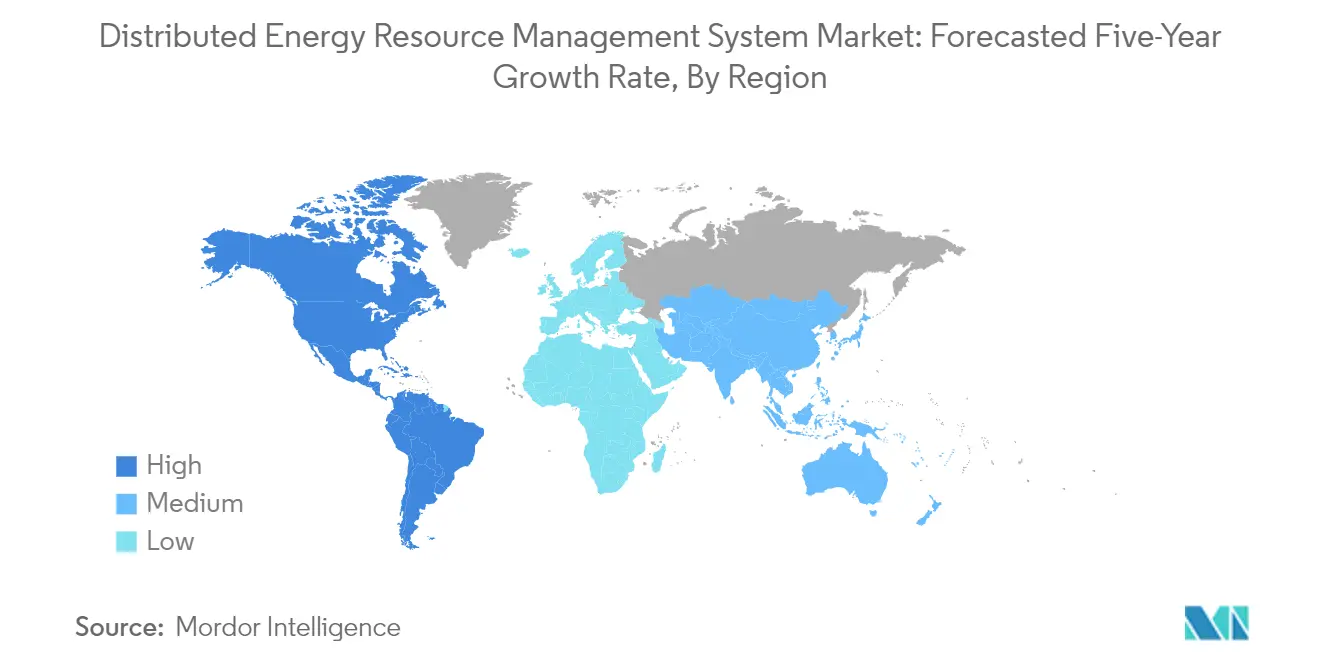
Distributed Energy Resource Management System Market in United States
The United States dominates the North American DERMS market size, holding approximately 81% market share in 2024. The country's leadership position is reinforced by ambitious renewable energy targets and substantial investments in grid modernization initiatives. The deployment of rooftop solar installations has seen remarkable growth, particularly in states like California, New York, and New Jersey, where favorable policies and incentives drive adoption. The country's commitment to electric vehicle infrastructure development, supported by the Bipartisan Infrastructure Law's allocation for building a national network of EV chargers, further strengthens the demand for sophisticated DERMS solutions. The integration of advanced monitoring technologies and smart grid management capabilities continues to evolve, making the U.S. market a benchmark for global DERMS implementation.
Growth Dynamics in United States DERMS Market
The United States is experiencing the fastest growth in the North American region, with a projected CAGR of approximately 21% from 2024 to 2029. This robust growth is driven by increasing investments in microgrid projects, with the U.S. Department of Energy announcing significant funding for grid resilience and reliability improvements. The country's focus on integrating distributed energy resources at both utility and consumer levels is creating new opportunities for DERMS providers. The expansion of virtual power plants and the implementation of advanced demand response programs are further accelerating market growth. Additionally, the increasing adoption of battery energy storage systems and their integration with renewable energy sources is creating a more complex grid environment that necessitates sophisticated DERMS solutions.
Distributed Energy Resource Management System Market in Europe
Europe demonstrates a strong commitment to distributed energy resource management systems as part of its broader energy transition strategy. The region's market is characterized by progressive policies supporting renewable energy integration and grid modernization across countries including the United Kingdom, Germany, France, and Italy. The European Union's ambitious climate goals and initiatives like the REPower EU program are driving the adoption of DERMS solutions. The region's focus on building integrated photovoltaics (BIPV) and the increasing deployment of electric vehicle charging infrastructure are creating new opportunities for DERMS implementation across residential, commercial, and industrial sectors.
Distributed Energy Resource Management System Market in United Kingdom
The United Kingdom leads the European DERMS market size, commanding approximately 20% market share in 2024. The country's leadership is underpinned by its comprehensive approach to grid modernization and renewable energy integration. The UK's ambitious target to raise solar capacity to 70 gigawatts by 2035 has catalyzed the adoption of DERMS solutions. The nation's robust electric vehicle charging infrastructure development and the increasing penetration of distributed energy resources have created a sophisticated market environment. The UK's focus on smart grid management technologies and advanced metering infrastructure continues to drive innovation in DERMS applications.
Growth Dynamics in United Kingdom DERMS Market
The United Kingdom is experiencing the highest growth rate in the European region, with a projected CAGR of approximately 20% from 2024 to 2029. This exceptional growth is driven by the country's aggressive renewable energy targets and substantial investments in grid infrastructure modernization. The UK's commitment to electric vehicle adoption and the rapid expansion of charging infrastructure are creating new demands for sophisticated DERMS solutions. The integration of battery storage systems and the development of virtual power plants are further accelerating market growth. Additionally, the country's focus on residential and commercial rooftop solar installations is creating a more distributed energy landscape that requires advanced management systems.
Distributed Energy Resource Management System Market in Asia-Pacific
The Asia-Pacific region represents a dynamic and rapidly evolving distributed energy resource management system market, driven by increasing renewable energy adoption and grid modernization initiatives. Countries including China, Japan, India, and South Korea are making significant strides in implementing DERMS solutions to manage their growing distributed energy resources. The region's rapid urbanization, increasing energy demand, and commitment to reducing carbon emissions are creating favorable conditions for DERMS adoption. Government initiatives supporting renewable energy integration and smart grid development are shaping the market landscape across the Asia-Pacific region.
Distributed Energy Resource Management System Market in China
China leads the Asia-Pacific distributed energy resource management system market, demonstrating remarkable progress in distributed energy resource management. The country's leadership in renewable energy deployment, particularly in distributed solar PV installations, has created a sophisticated market for DERMS solutions. China's commitment to grid modernization and the integration of advanced technologies for energy management has positioned it as a key player in the regional market. The nation's focus on developing smart grid infrastructure and implementing innovative energy management solutions continues to drive market growth.
Growth Dynamics in India DERMS Market
India is emerging as one of the fastest-growing markets for DERMS in the Asia-Pacific region. The country's ambitious renewable energy targets and increasing focus on distributed generation are driving market growth. India's commitment to installing rooftop solar panels and developing smart grid infrastructure is creating new opportunities for DERMS providers. The government's initiatives to promote renewable energy integration and grid modernization are fostering a favorable environment for market expansion. The country's focus on improving grid reliability and efficiency through advanced management systems is expected to sustain market growth.
Distributed Energy Resource Management System Market in South America
The South American DERMS market is experiencing steady growth, driven by increasing renewable energy adoption and grid modernization initiatives across the region. Brazil emerges as the largest market, while also demonstrating the fastest growth rate among South American countries. The region's focus on distributed solar generation and microgrid development is creating new opportunities for DERMS implementation. Countries like Brazil and Argentina are implementing supportive policies and regulatory frameworks to encourage the adoption of distributed energy resources. The integration of renewable energy sources and the development of smart grid infrastructure are key factors driving market growth across South America.
Distributed Energy Resource Management System Market in Middle East and Africa
The Middle East and Africa region presents an emerging market for distributed energy resource management systems, characterized by increasing investments in renewable energy infrastructure and grid modernization. Saudi Arabia represents the largest market in the region, while also showing the fastest growth rate among regional countries. The region's focus on solar energy deployment and smart grid development is creating new opportunities for DERMS implementation. Countries across the region are implementing initiatives to diversify their energy mix and improve grid reliability through advanced management systems. The growing adoption of distributed energy resources and the development of sustainable energy infrastructure are driving market growth across the Middle East and Africa.
Competitive Landscape
Top Companies in Distributed Energy Resource Management System Market
The market is led by established technology and industrial conglomerates including Schneider Electric SE, Siemens AG, General Electric Company, ABB Ltd, and Mitsubishi Electric Corporation. These DERMS companies are heavily investing in research and development to enhance their DERMS software capabilities, particularly in areas like artificial intelligence, machine learning, and blockchain integration. Strategic partnerships and collaborations have become increasingly common, with companies joining forces to develop more sophisticated grid management system solutions and expand their market reach. The industry has seen a strong focus on developing turnkey solutions that can seamlessly integrate various distributed energy resources while ensuring cybersecurity and grid stability. Companies are also expanding their geographical presence through strategic acquisitions and partnerships with local players, particularly in emerging markets where grid modernization initiatives are gaining momentum.
Dynamic Market Structure Drives Industry Evolution
The DERMS market exhibits a moderately consolidated structure, dominated by large multinational corporations with extensive experience in power systems and grid management system solutions. These established players leverage their strong financial positions and technological expertise to maintain market leadership, while also benefiting from their existing relationships with utilities and power companies. The market has witnessed significant merger and acquisition activity, with larger companies acquiring innovative startups and specialized software providers to enhance their technological capabilities and expand their solution portfolios. Regional players, particularly in Asia-Pacific and Europe, are gaining prominence by offering localized solutions that address specific grid management challenges in their respective markets.
The competitive landscape is characterized by a mix of traditional power equipment manufacturers who have expanded into software solutions and pure-play DERMS providers who focus exclusively on developing specialized management systems. Market consolidation has been driven by the need to create comprehensive solution offerings that can handle increasingly complex grid management requirements. Companies are forming strategic alliances with technology providers, utilities, and research institutions to strengthen their market position and drive innovation in grid management solutions.
Innovation and Integration Drive Future Success
Success in the DERMS market increasingly depends on companies' ability to provide scalable, flexible solutions that can adapt to evolving grid requirements and regulatory frameworks. Market leaders are focusing on developing platform-agnostic solutions that can integrate with existing utility infrastructure while providing advanced analytics and control capabilities. The ability to offer comprehensive cybersecurity features and ensure reliable grid operations has become crucial for maintaining market position. Companies are also investing in customer education and support services to help utilities maximize the benefits of their DERMS implementations.
For new entrants and smaller players, success lies in identifying and addressing specific market niches or regional requirements that larger players may have overlooked. The development of specialized solutions for microgrids, virtual power plants, and specific types of distributed energy resources presents opportunities for market differentiation. Companies must also navigate complex regulatory environments and maintain strong relationships with utilities and grid operators to ensure long-term success. The increasing focus on grid modernization and renewable energy integration creates opportunities for innovative solutions, while the high concentration of utility customers and the critical nature of grid operations necessitate robust, reliable solutions with strong technical support capabilities.
Distributed Energy Resource Management System Industry Leaders
-
Engie SA
-
General Electric Company
-
Siemens AG
-
Schneider Electric SE
-
ABB Ltd
- *Disclaimer: Major Players sorted in no particular order
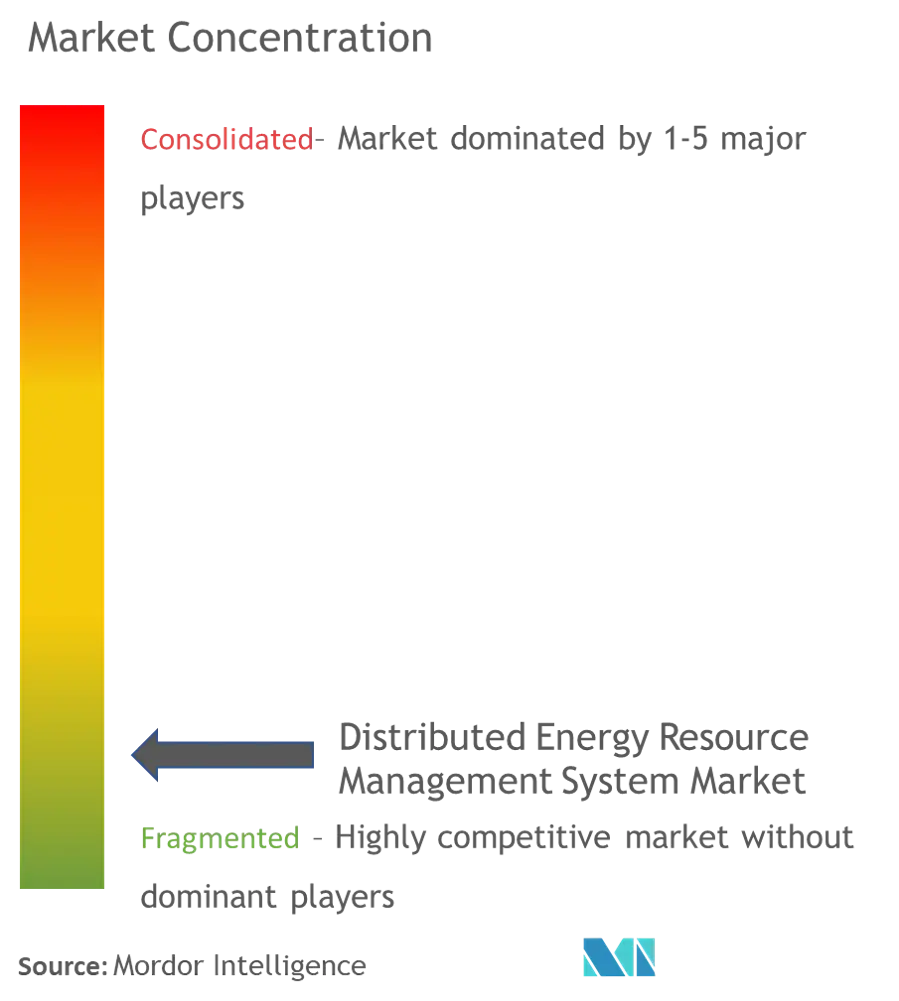
Recent Industry Developments
- February 2024: According to the N.C. Clean Energy Technology Center (NCCETC), a total of 774 grid modernization actions were taken in more than fifty states in 2023. The top trend in grid modernization includes the growing interest in virtual power plants, cost recovery for interconnection upgrades, examining the impacts of wholesale market participation, studying long-duration energy storage, utilities proposing new performance incentive mechanisms, undertaking grid resilience planning, utilities pursuing pilot programs and projects, utilizing green button standards for access to customer energy usage data, providing customers with demand response incentive opportunities, and utilities exploring opt-out time-varying rates.
- January 2024: According to a renewable report of IEA, the world’s capacity to generate renewable electricity is expanding faster, providing an opportunity to achieve the goal of tripling global capacity by 2030 that governments set at the COP28 climate change conference last month. The amount of renewable energy capacity added to energy systems grew by 50% in 2023, reaching almost 510 GW, with solar PV accounting for three-quarters of additions globally.
- April 2023: Alloy.ai, a software platform, announced the launch of new features that make it the first demand and inventory control tower designed specifically for consumer brands. The Alloy.ai application is built on a data platform that automatically aggregates, harmonizes, and synchronizes point-of-sale (POS) data from all of a company's retail and e-commerce channels with inventory and internal supply chain data from ERP systems.
Global Distributed Energy Resource Management System Market Report Scope
A distributed energy resources management system (DERMS) is a platform that helps distribution system operators (DSO) manage their grids, which are primarily based on distributed energy resources (DER).
The distributed energy resource management system (DERMS) market is segmented by technology, end user, and geography. The market is segmented by technology into solar photovoltaic (PV), electric vehicles, microgrids, and other technologies. By geography, the market is segmented into North America, Europe, Asia-Pacific, South America, and Middle East and Africa. By end user, the market is segmented into industrial, residential, and commercial. The report also covers the market size and forecasts across major regions. For each segment, the market sizing and forecasts were made based on revenue (USD).
| Solar Photovoltaic (PV) |
| Electric Vehicles |
| Microgrids |
| Other Technologies |
| Industrial |
| Residential |
| Commercial |
| North America | United States |
| Canada | |
| Rest of North America | |
| Europe | Germany |
| Italy | |
| France | |
| United Kingdom | |
| Rest of Europe | |
| Asia-Pacific | India |
| China | |
| Japan | |
| South Korea | |
| Rest of Asia-Pacific | |
| South America | Brazil |
| Argentina | |
| Rest of South America | |
| Middle East and Africa | United Arab Emirates |
| Saudi Arabia | |
| Saudi Arabia | |
| Rest of Middle East and Africa |
| By Technology | Solar Photovoltaic (PV) | |
| Electric Vehicles | ||
| Microgrids | ||
| Other Technologies | ||
| By End User | Industrial | |
| Residential | ||
| Commercial | ||
| By Geography | North America | United States |
| Canada | ||
| Rest of North America | ||
| Europe | Germany | |
| Italy | ||
| France | ||
| United Kingdom | ||
| Rest of Europe | ||
| Asia-Pacific | India | |
| China | ||
| Japan | ||
| South Korea | ||
| Rest of Asia-Pacific | ||
| South America | Brazil | |
| Argentina | ||
| Rest of South America | ||
| Middle East and Africa | United Arab Emirates | |
| Saudi Arabia | ||
| Saudi Arabia | ||
| Rest of Middle East and Africa | ||
Key Questions Answered in the Report
How big is the Distributed Energy Resource Management System Market?
The Distributed Energy Resource Management System Market size is expected to reach USD 1.42 billion in 2025 and grow at a CAGR of 18.31% to reach USD 3.29 billion by 2030.
What is the current Distributed Energy Resource Management System Market size?
In 2025, the Distributed Energy Resource Management System Market size is expected to reach USD 1.42 billion.
Who are the key players in Distributed Energy Resource Management System Market?
Engie SA, General Electric Company, Siemens AG, Schneider Electric SE and ABB Ltd are the major companies operating in the Distributed Energy Resource Management System Market.
Which is the fastest growing region in Distributed Energy Resource Management System Market?
Asia Pacific is estimated to grow at the highest CAGR over the forecast period (2025-2030).
Which region has the biggest share in Distributed Energy Resource Management System Market?
In 2025, the North America accounts for the largest market share in Distributed Energy Resource Management System Market.
What years does this Distributed Energy Resource Management System Market cover, and what was the market size in 2024?
In 2024, the Distributed Energy Resource Management System Market size was estimated at USD 1.16 billion. The report covers the Distributed Energy Resource Management System Market historical market size for years: 2019, 2020, 2021, 2022, 2023 and 2024. The report also forecasts the Distributed Energy Resource Management System Market size for years: 2025, 2026, 2027, 2028, 2029 and 2030.
Page last updated on:
